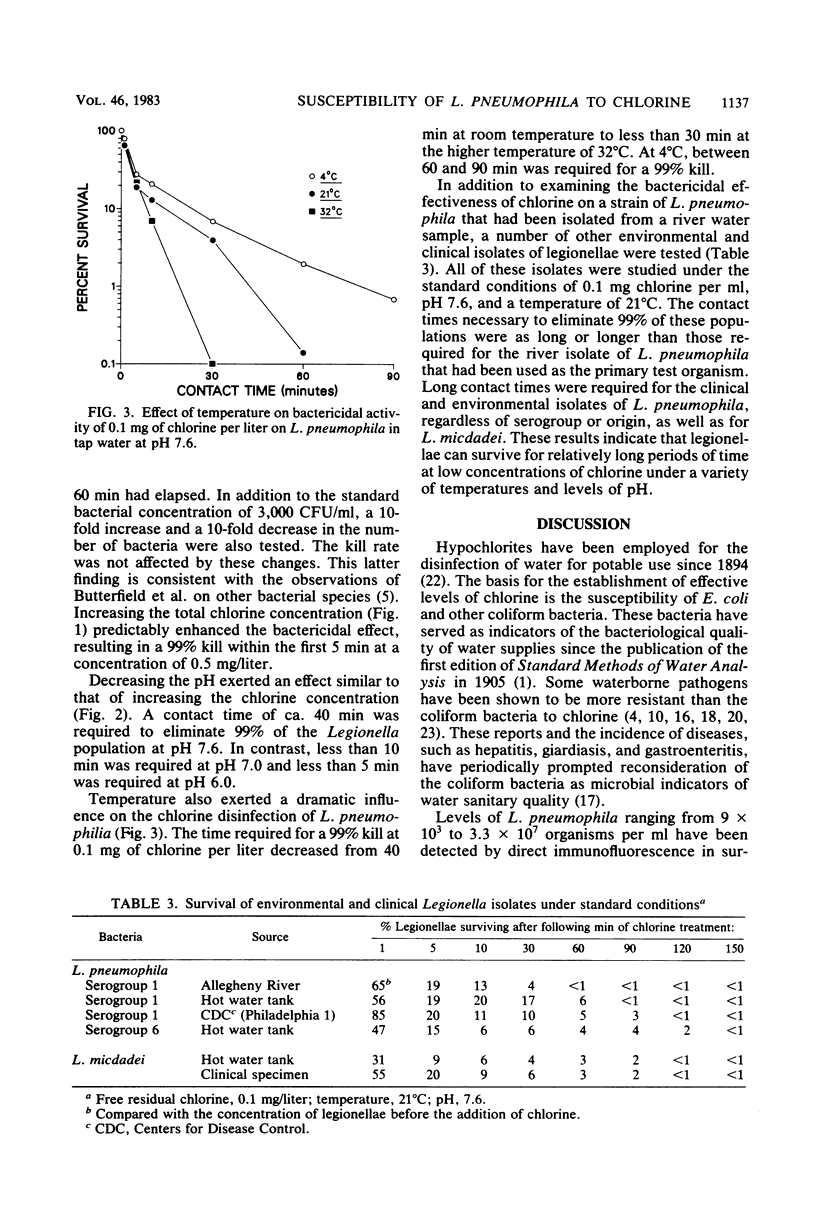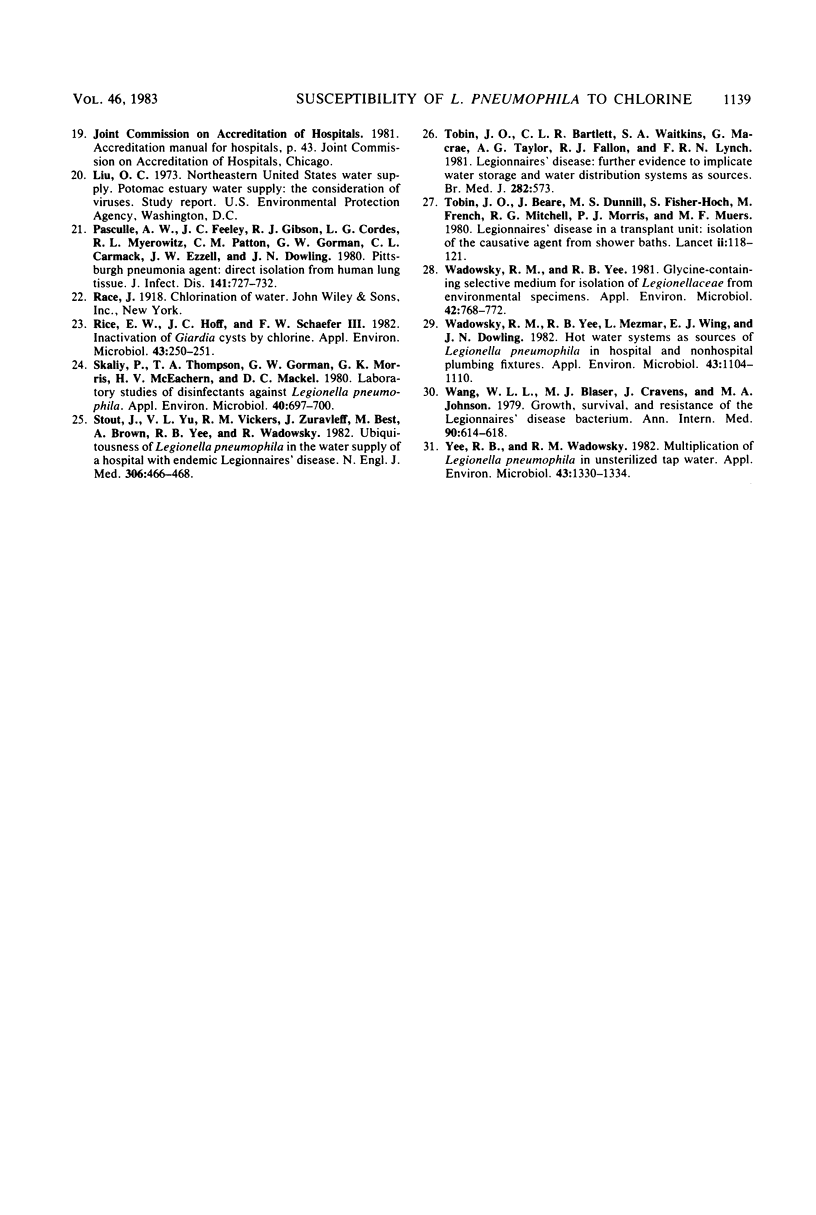Abstract
A study was conducted to compare the susceptibility of legionellae and coliforms to disinfection by chlorine. The chlorine residuals used were similar to concentrations that might be found in the distribution systems of large public potable water supplies. The effects of various chlorine concentrations, temperatures, and pH levels were considered. A number of different Legionella strains, both environmental and clinical, were tested. The results indicate that legionellae are much more resistant to chlorine than are coliform bacteria. At 21 degrees C, pH 7.6, and 0.1 mg of free chlorine residual per liter, a 99% kill of L. pneumophila was achieved within 40 min, compared with less than 1 min for Escherichia coli. The observed resistance is enhanced as conditions for disinfection become less optimal. The required contact time for the removal of L. pneumophilia was twice as long at 4 degrees C than it was at 21 degrees C. These data suggest that legionellae can survive low levels of chlorine for relatively long periods of time.
Full text
PDF





Selected References
These references are in PubMed. This may not be the complete list of references from this article.
- BRAZIS A. R., LESLIE J. E., KABLER P. W., WOODWARD R. L. The inactivation of spores of Bacillus globigii and Bacillus anthracis by free available chlorine. Appl Microbiol. 1958 Sep;6(5):338–342. doi: 10.1128/am.6.5.338-342.1958. [DOI] [PMC free article] [PubMed] [Google Scholar]
- Bopp C. A., Sumner J. W., Morris G. K., Wells J. G. Isolation of Legionella spp. from environmental water samples by low-pH treatment and use of a selective medium. J Clin Microbiol. 1981 Apr;13(4):714–719. doi: 10.1128/jcm.13.4.714-719.1981. [DOI] [PMC free article] [PubMed] [Google Scholar]
- Cherry W. B., Pittman B., Harris P. P., Hebert G. A., Thomason B. M., Thacker L., Weaver R. E. Detection of Legionnaires disease bacteria by direct immunofluorescent staining. J Clin Microbiol. 1978 Sep;8(3):329–338. doi: 10.1128/jcm.8.3.329-338.1978. [DOI] [PMC free article] [PubMed] [Google Scholar]
- Cordes L. G., Wiesenthal A. M., Gorman G. W., Phair J. P., Sommers H. M., Brown A., Yu V. L., Magnussen M. H., Meyer R. D., Wolf J. S. Isolation of Legionella pneumophila from hospital shower heads. Ann Intern Med. 1981 Feb;94(2):195–197. doi: 10.7326/0003-4819-94-2-195. [DOI] [PubMed] [Google Scholar]
- Dennis P. J., Taylor J. A., Fitzgeorge R. B., Bartlett C. L., Barrow G. I. Legionella pneumophila in water plumbing systems. Lancet. 1982 Apr 24;1(8278):949–951. doi: 10.1016/s0140-6736(82)91944-4. [DOI] [PubMed] [Google Scholar]
- England A. C., 3rd, Fraser D. W., Mallison G. F., Mackel D. C., Skaliy P., Gorman G. W. Failure of Legionella pneumophila sensitivities to predict culture results from disinfectant-treated air-conditioning cooling towers. Appl Environ Microbiol. 1982 Jan;43(1):240–244. doi: 10.1128/aem.43.1.240-244.1982. [DOI] [PMC free article] [PubMed] [Google Scholar]
- Fisher-Hoch S. P., Bartlett C. L., Tobin J. O., Gillett M. B., Nelson A. M., Pritchard J. E., Smith M. G., Swann R. A., Talbot J. M., Thomas J. A. Investigation and control of an outbreaks of legionnaires' disease in a district general hospital. Lancet. 1981 Apr 25;1(8226):932–936. doi: 10.1016/s0140-6736(81)91626-3. [DOI] [PubMed] [Google Scholar]
- Fliermans C. B., Cherry W. B., Orrison L. H., Thacker L. Isolation of Legionella pneumophila from nonepidemic-related aquatic habitats. Appl Environ Microbiol. 1979 Jun;37(6):1239–1242. doi: 10.1128/aem.37.6.1239-1242.1979. [DOI] [PMC free article] [PubMed] [Google Scholar]
- Grace R. D., Dewar N. E., Barnes W. G., Hodges G. R. Susceptibility of Legionella pneumophila to three cooling tower microbicides. Appl Environ Microbiol. 1981 Jan;41(1):233–236. doi: 10.1128/aem.41.1.233-236.1981. [DOI] [PMC free article] [PubMed] [Google Scholar]
- Jarroll E. L., Bingham A. K., Meyer E. A. Effect of chlorine on Giardia lamblia cyst viability. Appl Environ Microbiol. 1981 Feb;41(2):483–487. doi: 10.1128/aem.41.2.483-487.1981. [DOI] [PMC free article] [PubMed] [Google Scholar]
- Pasculle A. W., Feeley J. C., Gibson R. J., Cordes L. G., Myerowitz R. L., Patton C. M., Gorman G. W., Carmack C. L., Ezzell J. W., Dowling J. N. Pittsburgh pneumonia agent: direct isolation from human lung tissue. J Infect Dis. 1980 Jun;141(6):727–732. doi: 10.1093/infdis/141.6.727. [DOI] [PubMed] [Google Scholar]
- Public Health Weekly Reports for DECEMBER 17, 1943. Public Health Rep. 1943 Dec 17;58(51):1837–1880. [PMC free article] [PubMed] [Google Scholar]
- Rice E. W., Hoff J. C., Schaefer F. W., 3rd Inactivation of Giardia cysts by chlorine. Appl Environ Microbiol. 1982 Jan;43(1):250–251. doi: 10.1128/aem.43.1.250-251.1982. [DOI] [PMC free article] [PubMed] [Google Scholar]
- Skaliy P., Thompson T. A., Gorman G. W., Morris G. K., McEachern H. V., Mackel D. C. Laboratory studies of disinfectants against Legionella pneumophila. Appl Environ Microbiol. 1980 Oct;40(4):697–700. doi: 10.1128/aem.40.4.697-700.1980. [DOI] [PMC free article] [PubMed] [Google Scholar]
- Stout J., Yu V. L., Vickers R. M., Zuravleff J., Best M., Brown A., Yee R. B., Wadowsky R. Ubiquitousness of Legionella pneumophila in the water supply of a hospital with endemic Legionnaires' disease. N Engl J Med. 1982 Feb 25;306(8):466–468. doi: 10.1056/NEJM198202253060807. [DOI] [PubMed] [Google Scholar]
- Tobin J. O., Bartlett C. L., Waitkins S. A., Barrow G. I., Macrae A. D., Taylor A. G., Fallon R. J., Lynch F. R. Legionnaires' disease: further evidence to implicate water storage and distribution systems as sources. Br Med J (Clin Res Ed) 1981 Feb 14;282(6263):573–573. doi: 10.1136/bmj.282.6263.573. [DOI] [PMC free article] [PubMed] [Google Scholar]
- Tobin J. O., Beare J., Dunnill M. S., Fisher-Hoch S., French M., Mitchell R. G., Morris P. J., Muers M. F. Legionnaires' disease in a transplant unit: isolation of the causative agent from shower baths. Lancet. 1980 Jul 19;2(8186):118–121. doi: 10.1016/s0140-6736(80)90005-7. [DOI] [PubMed] [Google Scholar]
- Wadowsky R. M., Yee R. B. Glycine-containing selective medium for isolation of Legionellaceae from environmental specimens. Appl Environ Microbiol. 1981 Nov;42(5):768–772. doi: 10.1128/aem.42.5.768-772.1981. [DOI] [PMC free article] [PubMed] [Google Scholar]
- Wadowsky R. M., Yee R. B., Mezmar L., Wing E. J., Dowling J. N. Hot water systems as sources of Legionella pneumophila in hospital and nonhospital plumbing fixtures. Appl Environ Microbiol. 1982 May;43(5):1104–1110. doi: 10.1128/aem.43.5.1104-1110.1982. [DOI] [PMC free article] [PubMed] [Google Scholar]
- Wang W. L., Blaser M. J., Cravens J., Johnson M. A. Growth, survival, and resistance of the Legionnaires' disease bacterium. Ann Intern Med. 1979 Apr;90(4):614–618. doi: 10.7326/0003-4819-90-4-614. [DOI] [PubMed] [Google Scholar]
- Yee R. B., Wadowsky R. M. Multiplication of Legionella pneumophila in unsterilized tap water. Appl Environ Microbiol. 1982 Jun;43(6):1330–1334. doi: 10.1128/aem.43.6.1330-1334.1982. [DOI] [PMC free article] [PubMed] [Google Scholar]


